By CHRIS McGOWAN
Images courtesy of 20th Century Studios.
By CHRIS McGOWAN
Images courtesy of 20th Century Studios.

John David Washington portrays Joshua, a hardened ex-Special Forces agent recruited to hunt down and destroy the Creator, the elusive architect of advanced AI who has supposedly developed a mysterious world-ending weapon.
The sci-fi action thriller The Creator is set amidst a future war between the human race and the forces of artificial intelligence after a nuclear warhead has devastated Los Angeles. Director Gareth Edwards (Rogue One: A Star Wars Story) and his team based their elaborate world-building on a meticulous refinement of their visual ideas and extensive real-world photography; the latter included shots at 32 locations in Southeast Asia and thousands of reference photos. ILM Visual Effects Supervisor Jay Cooper comments, “I love the way Gareth chose to start with real locations when possible and build our sci-fi world around them. There is an authenticity to this approach that grounds the film.”
ILM Associate Visual Effects Supervisor Trevor Hazel adds, “The main challenge in creating a post-apocalyptic new world is doing something that hasn’t been done. Gareth wanted to create a world that was based in reality – there were no greenscreen shoots [for] this film. Gareth and a small team shot at numerous locations and incorporated many real people, their wardrobe and their community. He wanted the audience to watch the film and never be sure what was really captured in-camera.”
“What we created together is a mix of live-action anime, old school sci-fi and Baraka [the 1992 documentary with shots of people and settings around the world],” Hazel comments. The Creator, distributed by 20th Century Studios, reunited director Edwards, co-screenwriter Chris Weitz, Cinematographer Greig Fraser and ILM, all veterans of Rogue One.
In The Creator, Joshua (John David Washington) portrays a hardened ex-Special Forces agent mourning the disappearance of his wife (Gemma Chan). He is recruited to hunt down and destroy the Creator, the elusive architect of advanced AI who has supposedly developed a mysterious weapon with the power to end the war, as well as all mankind.

Director Edwards, co-screenwriter Chris Weitz, Cinematographer Greig Fraser and ILM were all veterans of Rogue One: A Star Wars Story, which gave The Creator a head start with the VFX. (Photo: Oren Soffer)
Joshua and his team of elite soldiers venture across enemy lines into the heart of AI-occupied territory. There, they discover that the world-ending weapon Joshua has been ordered to destroy is in the form of Alphie, a robotic child (Madeleine Yuna Voyles).
Edwards’s past experience as a visual effects artist and his previous collaboration with ILM gave The Creator a head start with the project’s VFX. “Gareth had a close relationship with ILM already, due to working together on Rogue One. When we began work on The Creator, he came to our San Francisco studio for a virtual camera shoot on our stage,” Hazel comments. “Right off the bat, he seemed at home and comfortable back at ILM to begin his new project.”
ILM was the lead VFX studio and handled just shy of 900 visual effects, with other work carried out by vendors including MARZ, Crafty Apes, Folks VFX, Outpost VFX, Jellyfish Pictures, Wētā Workshop, Supreme Studio, Territory Studio, Clear Angle Studios, Fin Design + Effects and Proof, Inc.

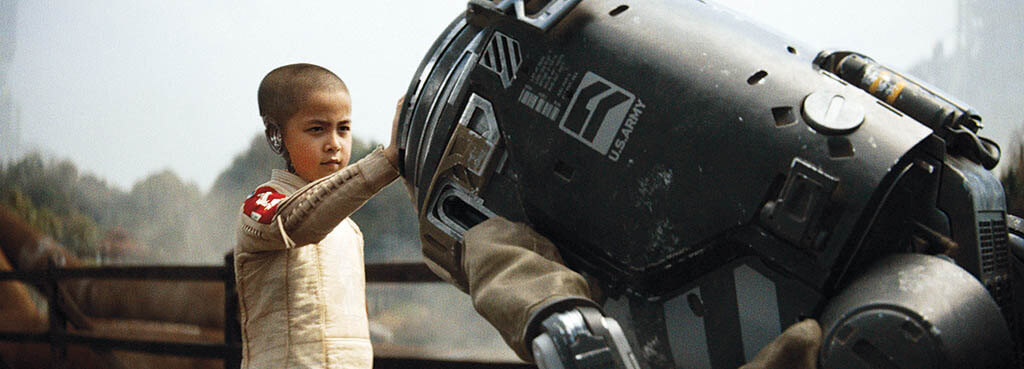
The world-ending weapon Joshua (John David Washington) has been ordered to destroy is in the form of Alphie, a robotic child (Madeleine Yuna Voyles). It was important to make Alphie accessible, yet not read as human.

Final destruction of the Nomad space station was a complex beat where the VFX team had to destroy the ship externally and internally. Scouting the digital sets in Unreal Engine prior to shooting allowed the team to experiment with Nomad’s scale, location and orientation.

The film’s elaborate world-building was based on a meticulous refinement of visual ideas and extensive real-world photography.

In a future war between the human race and the forces of artificial intelligence, Los Angeles has been devastated by a nuclear strike.
Edwards made it a point to try and collaborate directly with ILM, and he visited both San Francisco and London multiple times, whether it be for reviews, virtual cam sessions or virtual production shoots. “He wanted to be integrated with the whole team,” notes Charmaine Chan, ILM Visual Effects Supervisor.
Hazel adds, “It was wonderful working so closely with Gareth in creating his new world. Gareth is part storyteller, part cameraman and part graphic/VFX artist. He’s a great partner that knows our VFX world well, and it really helped our global team of artists dream big. We spent a lot of time getting the details right, and it paid off when everything came together.”
Edwards often showed that he is deeply conversant in visual effects techniques and challenges, according to Andrew Roberts, ILM On-Set Visual Effects Supervisor. “During one scene, a grenade explosion launches some robot police through the air. The rachet pull rig wasn’t working as intended on the stuntmen, and after a few failed attempts I approached Gareth to discuss digi-double options, and he turned to me and asked, ‘Can ILM do a ragdoll sim to throw them around more violently?’ I gave him the thumbs up, and Gareth was happy to move on to the next setup, confident our team would deliver the effect he needed.”

Director Gareth Edwards and his team built the world of The Creator around real locations to ground the sci-fi film in an environmental/cultural authenticity.
“The main challenge in creating a post-apocalyptic new world is doing something that hasn’t been done. Gareth [Director Edwards] wanted to create a world that was based in reality – there were no greenscreen shoots [for] this film. … He wanted the audience to watch the film and never be sure what was really captured in-camera. What we created together is a mix of live-action anime, old school sci-fi and Baraka [a 1992 world-conscious documentary].”
—Trevor Hazel, Associate Visual Effects Supervisor, ILM
Cooper explains, “Gareth has an extraordinary knack for visual storytelling, and this especially shone through in a science fiction film with extensive world-building. His understanding of the genre and his background in visual effects meant that he was very hands-on and had a deep comprehension of what was technically feasible. What stood out was his commitment to the characters and the worlds we were creating. He pushed the team to think outside the box and encouraged an environment of open communication and collaboration. It was refreshing to see a director so invested in the details, as Gareth often provided invaluable insights that elevated both the character development and the environmental design.”
From the beginning of The Creator, the ILM VFX team also worked closely with Production Designer James Clyne and the art department. “Gareth and James had a shorthand for the design language of the film, and we would go to that well of knowledge again and again for huge environments as well as small asset details,” Hazel notes.
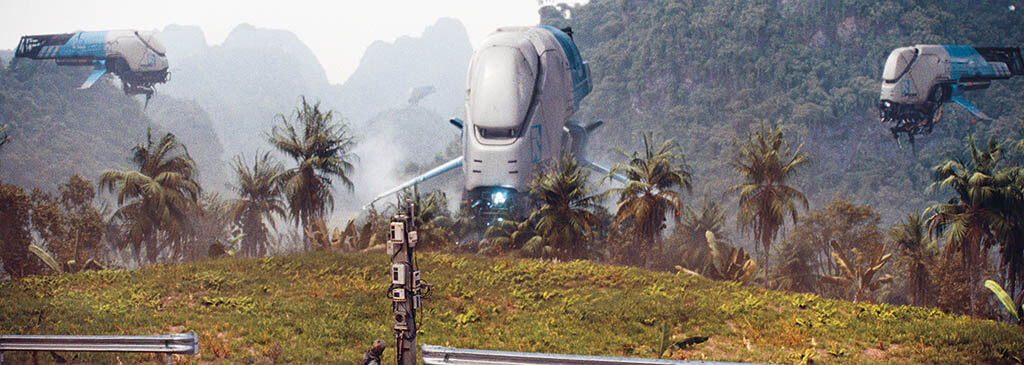
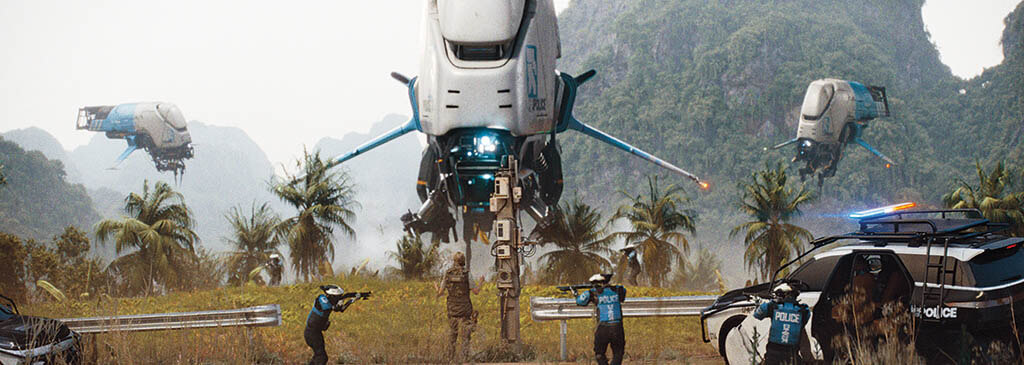
Director Gareth Edwards and his team built the world of The Creator around real locations to ground the sci-fi film in an environmental/cultural authenticity.


The biggest and most enjoyable challenge for the VFX team was creating from scratch a post-apocalyptic world that didn’t exist before.
“[For the destruction of the Nomad space station] we referenced historic Bikini Atoll footage, looking at the rapid formation and vaporization of clouds, as well as, of course, the classic mushroom. The simulation, at high altitude and with the Nomad creating an axis down the middle, led to a vast double-mushroom-cloud effect.”
—Ian Comley, Visual Effects Supervisor, ILM
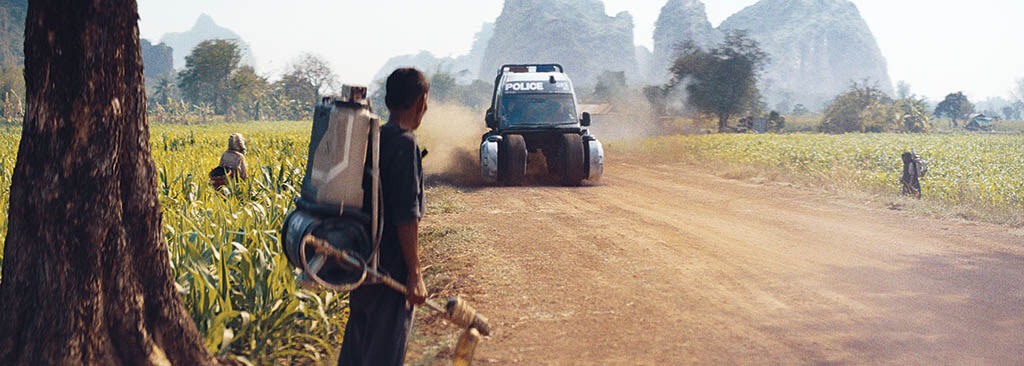

Real-world photography included shots at 32 locations in Southeast Asia and thousands of reference photos.
Edwards and Clyne constructed the rich design framework. “They had been looking at concepts and living within the world of The Creator for such a long time that when we showed Gareth one particular shot of a hero CG pyrotechnic effect, he instead honed straight in on the font used for a logo on a background wall, which did not fit within the design language of the film,” recalls ILM Visual Effects Supervisor Ian Comley.
“It’s so rare to be on a project where the Production Designer is on from the start to the very end. The art department was absolutely vital for Gareth’s vision, and he couldn’t find a better partner than with James Clyne and the art department. We were on daily calls with James where he would provide such detailed visual guides for our environments and assets. You could see how much Gareth relied on James, so having such a direct and close relationship with James proved to be a huge advantage,” Chan comments.
The visuals in The Creator were subject to a great many changes. “One aspect of this film that is unique is that we didn’t shoot plates on set knowing exactly what the final result was going to be,” Cooper says. “Gareth’s idea was that we would find a set location that could serve as the core of a set piece and that we would figure out the rest in post. The checkpoint is a good example of that. We shot in a location that was a toll booth station, and then many months later James Clyne would sink his teeth into it with his team, with the intention of turning it into a super-cool sci-fi building. They would do multiple versions of concept art, using the plate as a starting point. We would then pick up his initial designs and get to work. Somewhere along the way, we would shuttle a version back to James and he would refine the idea, maybe adding serpentine channels of light, negative space, or refining the visual language.”
It was important to Edwards that the art wasn’t the end of the design journey. Cooper comments, “It would evolve as he saw it with a moving camera, or with realistic textures. This was especially true when it came to the Nomad space station and our robot characters. We would look at something about the Nomad in art and like it, then flesh it out in 3D, and fall out of love, improve it in 3D and then move forward. It was a partnership with James and the production design team. One that started before principal photography and ended really only in the last weeks.”
“Gareth, James and Thai Art Director Lek Chaiyan Chunsuttiwat poured an incredible amount of design and attention into physical props, weapons, background robots, right down to everyday objects like phone booths and picture frames that made up the world of The Creator,” recalls Roberts. “Visiting the art warehouse in Bangkok during pre-production, walking down aisles packed with simulants and utility robots was like being in an amazing sci-fi museum.” He continues, “We shot thousands of bracketed reference photos, took LiDAR scans and captured as much of the detail as possible so we could use it as a foundation for our visual effects work.”
The visual effects complemented the locations. For the Floating Village, a location in “New Asia” built into a riverbank, Gareth and his team found a beautiful location in Thailand where there was a village by the river. “What we did to make it look more post-apocalyptic was add these industrial abandoned buildings sitting in the background hills,” Chan says. “They weren’t the main focus but helped ground that vision – that was a common theme throughout the film.” Hazel adds, “ILM would replace some of the filmed people with robots and simulants, sometimes where you’d least expect it, and we would augment those real locations for our new world.”
The simulants (the most human-like, sophisticated AI models) posed technical challenges. Cooper explains, “The technical challenges were mostly around incorporating the mechanical head gear into a number of human characters. Humans are obviously non-rigid and their faces stretch and squash as they move and talk. We had to find ways to lock off parts of a human face and interface it with mechanical CG bits. We would animate the jaw of our skeletal rig to make it look like the simulants were operating their mechanical components when talking. We had hero geometry for our principal actors, but not for some of the extras who were elevated to become simulants. Every head is different, and our layout team and compositing teams did a spectacular job fitting these parts together.”
For the fatal blow to the Nomad, Edwards wanted something that had the scale and finality of a nuclear blast. “We referenced historic Bikini Atoll footage, looking at the rapid formation and vaporization of clouds, as well as, of course, the classic mushroom. The simulation, at high altitude and with the Nomad creating an axis down the middle, led to a vast double-mushroom-cloud effect,” Comley says. Chan remarks, “The final destruction of the Nomad was a complex beat where we had to look at destroying the ship both externally and internally. As Ian mentioned, there was lots of research on the Bikini Atoll footage, but we also wanted to make sure that rippled into the interior sections of the ship. We had mini-sub explosions happening both inside and out, and destruction and debris falling dangerously close to our heroes in their final moments. We choreographed the buildup of more and more destruction until we had that one final explosion.”
ILM’s StageCraft was used for two locations on the space station Nomad – The Biosphere and an Escape Pod Bay. Comley comments, “We used our ILM StageCraft volume at Pinewood which was 55m x 43m [wxl] and 15m high. We had Vicon camera tracking and Roe Black Pearl BP2’s, which were 2.8mm pitch LEDs. We also used our in-house proprietary renderer at ILM called Helios to run out the content.”



An sci-fi-rich art warehouse in Bangkok provided thousands of reference photos, LiDAR scans and important details that served as a foundation for the visual effects work.

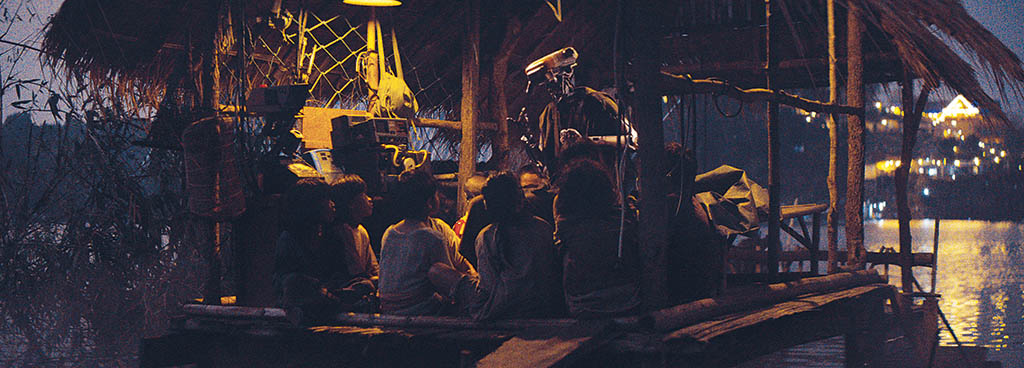
The Floating Village in “New Asia” was built into a riverbank at a idyllic location in Thailand where there was a village by the river. To make it look more post-apocalyptic, abandoned industrial buildings were added to the background hills.
Long before pre-production, Fraser, Edwards and Cooper discussed what environments they could target for StageCraft. “Greig is an expert when it comes to shooting with StageCraft, having served as a cinematographer on The Mandalorian and The Batman, both of which had large StageCraft elements, as well as Rogue One which had a proto ILM StageCraft volume. We chose two sequences [Escape Pod Bay/Airlock and Biosphere] that would work well with StageCraft. They’re both large and complicated sets that you couldn’t build, and ideally you would want to frame your shots, knowing what you’re looking at,” Cooper explains.
Roberts notes, “Prior to shooting, ILM went through an extensive design phase with Gareth and James Clyne. Our Virtual Art Department Supervisor, Billy Brooks, worked closely with Gareth scouting the digital sets in Unreal Engine. This allowed them to experiment with Nomad’s scale, location and orientation.”
Cooper adds, “Along the way, we would bring Gareth into our virtual world and have reviews using an Oculus headset. He could fly around our virtual sets, place cameras and inspect our build while it was in progress.”
Coming up with a look for the simulants and robots was an aesthetic challenge. Cooper recalls, “Finding ways to make Alphie [Alpha O] both accessible and robotic was extremely important. You don’t want her to be off-putting, and you want the audience to enjoy Madeline’s wonderful performance, but at the same time she shouldn’t read as human. We did several rounds of models to try to thread that needle and then gave her head mech some purpose and intent. Her ‘wheels’ spin in keeping with her performance.”
Continues Cooper, “On the aesthetic front, we were trying to design a world that was both huge in scope but also had uniting elements of design. Gareth wanted an aesthetic that had a fit and finish of polished industrial design. The design language had to feel intentional and refined. This was true for characters as well as environments.”
Cooper concludes, “It was exciting to work on a project that was original and wasn’t part of a larger story universe. There was a freedom and delight that came with starting with a clean slate.”